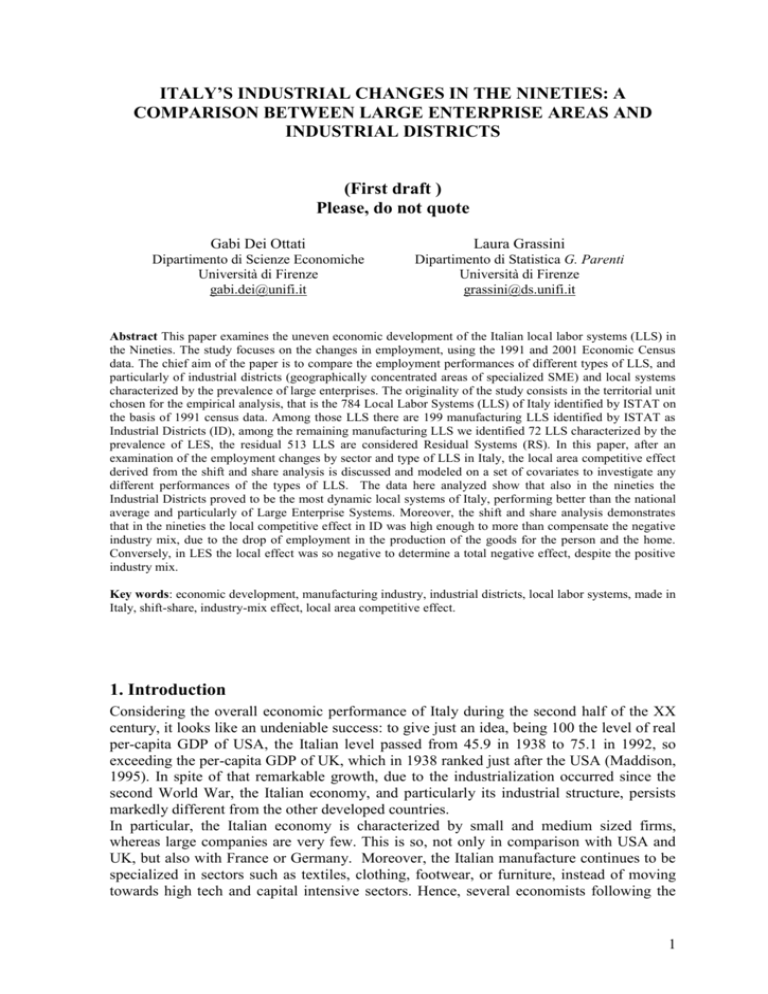territorial performances of the italian manufacturing industry in the 90`s
advertisement

ITALY’S INDUSTRIAL CHANGES IN THE NINETIES: A COMPARISON BETWEEN LARGE ENTERPRISE AREAS AND INDUSTRIAL DISTRICTS (First draft ) Please, do not quote Gabi Dei Ottati Laura Grassini Dipartimento di Scienze Economiche Università di Firenze gabi.dei@unifi.it Dipartimento di Statistica G. Parenti Università di Firenze grassini@ds.unifi.it Abstract This paper examines the uneven economic development of the Italian local labor systems (LLS) in the Nineties. The study focuses on the changes in employment, using the 1991 and 2001 Economic Census data. The chief aim of the paper is to compare the employment performances of different types of LLS, and particularly of industrial districts (geographically concentrated areas of specialized SME) and local systems characterized by the prevalence of large enterprises. The originality of the study consists in the territorial unit chosen for the empirical analysis, that is the 784 Local Labor Systems (LLS) of Italy identified by ISTAT on the basis of 1991 census data. Among those LLS there are 199 manufacturing LLS identified by ISTAT as Industrial Districts (ID), among the remaining manufacturing LLS we identified 72 LLS characterized by the prevalence of LES, the residual 513 LLS are considered Residual Systems (RS). In this paper, after an examination of the employment changes by sector and type of LLS in Italy, the local area competitive effect derived from the shift and share analysis is discussed and modeled on a set of covariates to investigate any different performances of the types of LLS. The data here analyzed show that also in the nineties the Industrial Districts proved to be the most dynamic local systems of Italy, performing better than the national average and particularly of Large Enterprise Systems. Moreover, the shift and share analysis demonstrates that in the nineties the local competitive effect in ID was high enough to more than compensate the negative industry mix, due to the drop of employment in the production of the goods for the person and the home. Conversely, in LES the local effect was so negative to determine a total negative effect, despite the positive industry mix. Key words: economic development, manufacturing industry, industrial districts, local labor systems, made in Italy, shift-share, industry-mix effect, local area competitive effect. 1. Introduction Considering the overall economic performance of Italy during the second half of the XX century, it looks like an undeniable success: to give just an idea, being 100 the level of real per-capita GDP of USA, the Italian level passed from 45.9 in 1938 to 75.1 in 1992, so exceeding the per-capita GDP of UK, which in 1938 ranked just after the USA (Maddison, 1995). In spite of that remarkable growth, due to the industrialization occurred since the second World War, the Italian economy, and particularly its industrial structure, persists markedly different from the other developed countries. In particular, the Italian economy is characterized by small and medium sized firms, whereas large companies are very few. This is so, not only in comparison with USA and UK, but also with France or Germany. Moreover, the Italian manufacture continues to be specialized in sectors such as textiles, clothing, footwear, or furniture, instead of moving towards high tech and capital intensive sectors. Hence, several economists following the 1 mainstream approach have recurrently indicated those features (the small size of firms and the specialization in so called traditional sectors) as responsible for the relative decline in the Italian GDP growth in the ’90s, and in more recent years. Our approach is different and the related interpretation is more complex. First of all, we believe that the prevailing small size of the Italian manufacturing firms and their economic activity specialization are two closely interlinked features (Becattini, 1996). Moreover, we think that those features cannot be properly understood without taking into account the territorial organization of the Italian economy: i.e. the importance of local systems and, especially, of those local systems characterized by many specialized small and medium sized enterprises (SME) that conform to the industrial district (ID) model1. According to that interpretation, any meaningful empirical study of the Italian economic development has to focus on the many different local systems that make up the mosaic of the country. Moreover, at this point, many studies have demonstrated that ID have played a remarkable role in the economic performance of Italy, at least since the ‘70s, especially as far as exports are concerned2. Various scholars3, and among them Michael Porter (1990), have by now proven the substantial correspondence between the development of industrial districts and the success of the Italian exports of goods for the person (textiles, clothing, leather goods, jewels…) and for the home (furniture, lighting equipment, tiles…) (Personal and Household Goods) , together with the related machine tools (Light Mechanics). Considering both the type of manufacturing specialization of Italy and the importance of ID for the Italian exports and economic development in general, we have chosen to focus the empirical analysis on local systems, instead of sectors at national level. Being convinced that the two main “engines” of the Italian economy are industrial districts (ID) and local areas characterized by one or more large enterprises (LES), our principal aim is to compare their relative performances during the ‘90s. In particular, first we examine Italy’s employment changes, by sector and by type of local system with a special focus on manufacturing. Then, we apply the shift and share analysis to the employment data, by sector and local system, in order to separate the industry-mix effect from the local competitive effect in the economic performance of the area. The paper proceeds as follows. In the next section the methodology and the data we use are specified. The economic performances of the different types of local systems are considered in section 3. Section 4 presents the shift and share analysis and the results of its applications. Some conclusions are drawn in section 5. 2. Data and methodology According to the approach outlined in the previous section, since it was not possible to make a direct comparison between the performances of large enterprises, a phenomenon that exists essentially at company level, with those of industrial districts, which is principally territorial, we had to choose a territorial unit of analysis suitable for the comparison. The best-known territorial definition of the Italian ID is the Istat-Sforzi (1997) The industrial district model of socio-economic organization has been defined as “a socio territorial entity which is characterized by the active presence of both a community of people and a population of firms in one …(local) area. In the district… community and firms tend to merge” Becattini 1990, p.38. Among the many contributions on industrial districts, we mention only some important collections of essays in English: Pyke et al. 1990, Pyke and Sengenberger 1992, Cossentino et al 1996, Becattini et al 2003, Becattini 2004. 2 See Becattini 1996, Brusco and Paba 1997, Dei Ottati 1996, Bellandi 1999, Signorini 2000, Becattini and Bellandi 2002, Becattini and Coltorti 2004, Becattini and Dei Ottati 2005. 3 See Becattini and Menghinello 1998, Fortis 1998. 1 2 one, which is based on the 1991 census “local labor systems”4. Specifically, out of the 784 LLS of Italy, there were identified 199 local labor systems having some features of the ID model5 Therefore, we decided to use the 199 ID identified by Istat-Sforzi. Furthermore, always on the basis of 1991 Census data, we found those non ID LLS characterized by a manufacturing industry with the prevalence of large enterprises, through the following procedure. Non ID LLS were selected according to the degree of manufacturing employment. The LLS with a degree of manufacturing employment over the national average were considered “large enterprises systems” (LES) if the share of employment was concentrated in large establishments (establishments with more than 249 workers). Residual systems (RS) are those which fall neither into the class of ID, nor in that of LES. Among the non ID LLS, we identified a total of 72 LES6. It is necessary to observe that, at the end of 2005, a new map of LLS based on 2001 Population Census data was released by ISTAT (ISTAT; 2005). In this paper, we used the map at 1991 because other statistical information has been produced at this geographical levels (for example: the time series 1996-2002 of added values and employment for each 1991 LLS), that allow future development of the study of the transformations occurred in Italy at the end of the century. Moreover, the new map of LLS is only partially different from the one of 1991. The number of LLS was in 1991 784 with 199 ID, whereas in 2001 there are 686 LLS with 156 ID. If we refer to the municipalities (the common unit in the two classifications), we have that: - 1856 of 2474 (83.8%) municipalities that in 1991 were in ID still belong in 2001 to ID; - 5268 of 5627 (89.5%) municipalities that in 1991 were not in ID still belong in 2001 to non-ID LLS; - a total of 7124 of 8101 (87.9%) municipalities do not change type of LLS between 1991 and 2001. Table 2.1 and Figure 2.1 give a picture of the geographical location of the three types of LLS. We adopted the usual classification into the Istat four Italian macro-regions. We can see that the North East and Center regions concentrate the largest number of ID, corresponding to the so called Third Italy (Bagnasco 1977); Southern areas, instead, are characterized by a large prevalence of RS, whereas, in the North-west of Italy there is the highest proportion of LES. Table 2.1: Geographical location of the different types of LLS (column percentages) LLS North west N. North east % N. Center South and isles % N. % N. % ID 59 42.2 65 45.5 LES 30 21.4 16 11.2 RS 51 36.4 62 43.4 Total 140 100.0 143 100.0 Classification based on 1991 Economic Census data. 60 13 63 136 44.1 9.6 46.3 100.0 15 13 337 365 4.1 3.6 92.3 100.0 Total 199 72 513 784 4 Local labor systems (LLS) are sets of contiguous towns or cities with a high degree of self-containment of daily commuter travel) 5 For the empirical identification of ID see Istat-Sforzi (1997). For the relationship between these and the ID model of organization, see Becattini (1987). 6 The identification of large enterprise systems (LES) is based on the total employment, whereas the empirical analysis developed in the paper is focused of firms’ employment (i.e.: public administration workers are excluded). 3 Figure 2.1: map of the LLS based on 1991 Population Census data Having accounted for the reason we chose the LLS as the territorial unit of analysis, we want now to specify the classification of the official ISTAT economic activities here used. Before focusing on manufacturing industry, we considered all the economic activities of firms, subdivided into the following sectors (Table 2.2). Table 2.2: Classification of economic activities Code Detail AB Products of agriculture, hunting, forestry (A); fish and other fishing products (B); CE Products from mining and quarrying (C); electrical energy, gas and water (E); D Manufactured products F Construction work G Wholesale and retail trade services; repair services for motor vehicles, motorcycles and personal and households goods H I J K MNO Hotel and restaurant services Transport, storage and communication services Financial intermediation services Real estate, renting and business services Education services (M), health and social work services (N), other community, social and personal services (O) 4 Some sectors that are considered less important for the purposes of this paper (for example: CE, AB) have been aggregated to obtain a synthetic picture of the whole economy and in order to render workable the shift and share analysis7. Having devoted a specific investigation to manufacturing industries, we have now to explain why we grouped the 14 sectors of the ISTAT official manufacturing activities into four clusters of products. This choice is mainly justified by the purpose to subdivide the Italian manufacture in a way that can reveal, instead of concealing, the products in which Italy has gained a competitive advantage, and their peculiar industrial organization. Therefore, we grouped together the goods for the person and for the home (PHG)8, which constitute the core of the Italian exports. Then, we classified as light mechanics (LM) the production of metal goods and machinery most of which are used to manufacture PHG, and whose share of the Italian exports is also significant. Actually, PHG and light mechanical engineering are so important for the Italian balance of trade, that they are often labeled as “made in Italy”. In particular, a large part of PHG manufactured in Italy have a high stylistic, cultural and even emotional value, as they remind the Italian art, landscape, climate and, more generally, way of living. Hence, PHG are clearly distinct from the usually undifferentiated mass products of most Italian heavy industry (Heavy), such as basic chemicals, or metals. The fourth cluster of manufactured goods is food and beverages (Food), which includes also some of the distinguishing products of the Mediterranean diet, such as olive oil or good reputed wines. As far as producer services (K sector) are concerned, we are particularly interested in the subcategories: Computer and related services (K72) and Other business services (K74)9. The reason for a deeper investigation of these services is their striking growth in the nineties, and by the fact that these services are also directly connected with the evolution of industrial firms in developed countries. Since the main aim of this paper is to compare the employment performances of ID and LES, it is necessary to isolate, as far as possible, if any, the ‘district effect’ 10. This is quite problematic, since local development variables not directly related to the districts and or institutional variables, like the legal structure of firms, may interact with the ID variable. For example, district LLS may exhibit higher performances just because ID are mainly located in regions with a higher quality of infrastructures (see table 2.1). For this reason, after considering the aggregate changes of the Italian LLS, we apply a shift and share analysis to the employment data, in order to find out the local competitive effect of each LLS. The presence of a local competitive effect will be subsequently modeled through a logit regression, as a function of dummies indicating the nature of the LLS, and other control variables including a measure of infrastructure endowment. 7 Note that, as we are interested in private firms, any public activity is not included in our data. For this reason, the economic activities L (Public administration services; compulsory social security services), P (Services of households), Q (Services provided by extra-territorial organizations and bodies) are excluded. 8 See the appendix for the manufacturing activities included in each cluster of products we considered. 9 The ISTAT classification of K sector is into: Real estate services (K70), Renting services of machinery and equipment without operator and of personal and household goods (K71), Computer and related services (K72), Research and development services (K73), Other business services (K74). Category K74 includes: Legal, accounting, bookkeeping and auditing activities; tax consultancy; market research and public opinion polling; business and management consultancy; Architectural, engineering and other technical activities; Advertising; Other business activities n.e.c. 10 This must not be intended as a causal relationship. We investigated, on cross.-sectional data, if the types of LLS is associated with different performances. 5 3. Economic changes in the Italian LLS In this section we present an overview of the main changes in employment for the three types of LLS here identified, first among the 10 sectors comprising the whole economy (3.1.), then with a deeper investigation in manufacturing industries (3.2.). 3.1. Employment changes by sector and type of LLS On the whole, the Italian firms workers during the Nineties grew of 1,138,606, corresponding to an increase of +7.8%. That average employment growth, however, was the result of different trends among the various economic activities, and LLS. While manufacturing (D) and mining, energy and water (CE) underwent remarkable reductions, respectively of -6.1% and -25.8% (corresponding to – 316,367 and to – 56,545 workers respectively), in construction (F) the employment increased of +14.7% (+196,396 workers). Nevertheless, the larger increases of workers were in the services, particularly in hotels and restaurants (H) and especially in real estate and producer services (K), which grew of +17.2% and +90.5% respectively (corresponding to +125,238 and even + 1,063,020 workers respectively). Among the activities comprised in K sector, those that grew faster were real estate services (+172.6%) and computer related services (+96.1%). After a brief look at the main changes among the sectors at the national level, we pass to consider the employment changes in the different types of LLS. As shown in table 3.1, with 10% increase, the ID had a better overall employment performance, in comparison with LES (+6.3%) and RS (+7.1%). This is the case, particularly in financial intermediation J (+13.3, against +1.2 of LES and +0.0 of RS) and producer services K (+97.4, against +94.1 of LES and 85.1 of RS), and in construction F (+18.3, against +12.6 of LES and +13.4 of RS) and chiefly in manufacturing D (-0.8, against -13.1 of LES and 7.4 of RS). The latter result confirms the relative strength of ID over LES in manufacturing activities, in spite of the industrial restructuring occurred in the Nineties which brought about a generalized drop in the related employment. Actually, in the nineties the share of manufacturing employment in ID grew, passing from 42.6% to 45% of all Italian manufacturing workers. Table 3.1: Italy’s employment changes (%) by sector and type of LLS: 1991-2001 ID LES RS Italy AB 2.0 -5.1 10.0 5.6 CE -16.3 -33.6 -26.0 -25.8 D -0.8 -13.1 -7.4 -6.1 F 18.3 12.6 13.4 14.7 G 0.0 -5.6 -6.4 -4.6 H 19.1 20.2 15.5 17.2 I 17.6 19.3 -1.3 6.4 J 13.3 1.2 0.0 3.3 K 97.4 94.1 85.1 90.5 MNO 23.7 25.6 20.1 22.0 Total 10.0 6.3 7.1 7.8 As a consequence of the economic evolution sketched above, the structure of Italy’s employment changed. Table 3.2 shows those changes. Manufacturing, while remaining the most important sector, reduced its share of employment, passing from 35.8% in 1991 to 31.2% in 2001 of all sectors workers, at national level, but with a larger relative reduction in LES (from 40.8% to 33.3%). Construction, instead, increased its weight (from 9.1% to 9.7%), particularly in ID (from 8.8% to 9.5%). The most spectacular change, however, was in real estate and producer services, whose share of the total employment passed from 8.1% in 1991 to 14.2% in 2001at national level, but with larger increases in LES (from 9.6% to 17.4%) and in ID (from 6.2% to 11.1%). 6 Table 3.2: Italy’s employment structure by sector and type of LLS: 1991 and 2001 (column percentages) 1991 Economic sectors AB: Agriculture, forestry, fishing CE: Mining, energy, water D: Manufacturing F: Construction G: Wholesale and retail H: Hotels, restaurants I: Transport equipment J: Financial services K: Real estate, renting, etc. MNO: Social services All sectors 2001 ID LES RS Italy ID LES RS Italy 0.6 0.9 49.1 8.8 19.1 3.8 4.6 2.8 6.2 4.2 0.4 1.4 40.8 7.3 20.6 3.8 6.7 4.5 9.6 4.8 0.8 2.0 24.1 10.3 26.2 6.4 10.3 4.3 8.6 7.0 0.6 1.5 35.8 9.1 22.7 5.0 7.7 3.9 8.1 5.7 0.6 0.7 44.2 9.5 17.3 4.1 4.9 2.9 11.1 4.7 0.3 0.9 33.3 7.8 18.3 4.3 7.5 4.3 17.4 5.7 0.8 1.4 20.8 10.9 22.9 6.9 9.5 4.1 14.8 7.9 0.6 1.0 31.2 9.7 20.1 5.4 7.6 3.7 14.2 6.4 100.0 100.0 100.0 100.0 100.0 100.0 100.0 100.0 3.2. Manufacturing employment changes by cluster of products and type of LLS Having outlined the Italy’s employment evolution in the Nineties by sector and type of LLS, we now go on analyzing in greater detail the manufacturing industry, giving its importance in the whole economy and, especially, in ID and LES which, by definition, are specialized in manufacturing Table 3.3 shows that the average employment drop of -6.1% was the outcome of different changes among the various clusters of manufactured products and types of LLS. As far as clusters of products are concerned, the largest decrease of workers occurred in heavy industries (10.8%, corresponding to 104,569 workers) and particularly in PHG (14.5%, corresponding to 308,014 workers) in whose production the larges part of the Italian manufacturing employment is concentrated. Within the PHG cluster the biggest reductions were in clothing (28.8%, corresponding to 120,616 workers of which -66,413 in ID), and in textiles (23.4%, corresponding to 94,437 workers of which 64,772 in ID). On the contrary, light mechanical engineering in the same decade augmented the employment (+7.3%, corresponding to + 119,277 workers, actually all in ID), particularly in machinery equipment (DK)11. As already noted, the largest relative fall in manufacturing employment occurred in LES, which registered a negative performance in all clusters of products here considered. In ID, on the other hand, the remarkable loss of jobs in PHG (14.1%) was almost counterbalanced by the increase of workers employed in heavy industries (+9.2%) and chiefly in light mechanical engineering (+17.7%, corresponding to 119,910), a typical subsidiary industry. This evidence confirms the dynamism of ID in the nineties, a decade characterized by strong globalizing processes. Table 3.3: Manufacturing employment changes (%) by cluster of products and type of LLS in Italy: 1991-2001 LLS ID Food PHG Heavy industry Light mechanics Total manufacture -0.8 -14.1 9.2 17.7 -0.8 LES -11.1 -18.0 -20.1 -3.8 -13.1 RS -4.9 -13.0 -15.3 4.0 -7.3 Italy -4.9 -14.5 -10.8 7.3 -6.1 11 Actually, in electrical and communication equipment (DL)in the nineties the total employment decreased of -5.2% as a consequence of an increase (+15.5%) in ID and a drop in LES (-18.4%) and RS (-8.0%). 7 Those economic changes are reflected also in the structure of employment by cluster of manufactured products and type of LLS. Table 3.4 shows the drop in PHG employment in all types of LLS, whose share in Italy passes from 40.8% in 1991 to 37.2% in 2001, with a larger reduction in ID (from 50.9% in 1991 to 44.1% in 2001). On the contrary, the generalized growth of light mechanical engineering (from 31.5% of the whole manufacture in 1991 to 36.0% in 2001) was higher in ID. These different trends changed the local industry mix in favour of light mechanical engineering. In spite of that, the same table demonstrates that in 2001 ID where still specialised in PHG, whereas LES had further reduced their share of heavy industry. Table 3.4: Manufacturing employment structure by cluster of products and type of LLS in Italy: 1991 and 2001 (column percentages) Economic sectors 1991 2001 ID LES RS Italy ID LES RS Italy 6.9 7.1 13.7 9.2 7.0 7.3 13.9 9.2 Personal and household goods 50.9 27.9 38.2 40.8 44.1 26.4 36.1 37.2 Heavy industry 11.7 29.2 19.1 18.5 12.7 26.7 17.3 17.6 Light mechanics 30.5 35.8 29.0 31.5 36.2 39.6 32.7 36.0 100.0 100.0 100.0 100.0 100.0 100.0 100.0 100.0 Food, beverages, tobacco Total manufacture Another view of the modifications occurred in the Italian manufacturing industry during the 90s is offered by table 3.5, which shows the average size of establishments by cluster of products and by type of LLS. A consequence of the industrial restructuring described above is that the average size of establishments in LES reduced by 1.7 workers (from 12.7 to 11), and in ID grew (from 9.0 to 9.3). This evidence suggests that the further reduction of the average size of the Italian manufacturing establishments (from 8.8 in 1991 to 8.3 in 2001) was more due to the crisis and fragmentation of large firms in LES, than to the incapacity of restructuring appropriately of the district’s SMEs. Table 3.5: average size (in workers) of manufacturing establishments by type of LLS in Italy: 1991 and 2001 LLS ID LES RS Italy 1991 9.0 12.7 6.8 8.8 2001 9.3 11.0 6.1 8.3 4. Shift and share analysis In this section we focus on the shift and share analysis of the Census data of the Italian industry, in the years 1991 and 2001. Below, we briefly introduce the shift-share model and symbols. 4.1 Methodology The shift-share technique is applied on 784 geographical areas (LLS) and the manufacturing clusters of products listed in the preceding sections (Food, PHG, Heavy industry, Light mechanics (LM). The method provides a decomposition of the difference 8 (YijXij), between employment in sector i and area j at time 2001 (Yij) and employment in sector i and area j at time 1991 (Xij), into the following sum: YijXij=Wij + Sij+ Rij (1) where: i=1,..,4; j=1,…,784; Wij =r..Mij, where r..=(Y.. X..)/M.. is a measure of the relative variation of Manufacture employment in the macro-area (Y.., X.. and M.. are the sum of Yij , Xij and Mij over i and j); Sij=(ri.r..)Mij, where ri.=(Yi.Xi.)/Mi. measures the relative variation of employment of sector i in the macro-area (Yi., Xi. and Mi. are the sum of Yij , Xij and Mij over j);. Rij=(rijr.j) Mij, with rij=(YijXij)/Mij, is the competitive effect of area j in sector i; when Rij>0 there is a local competitive gain; Mij=(Xij+Yij)/2. The reason of this modification of the traditional shift and share formula (i.e. the use of the mean Mij instead of the beginning time values Xij at the denominator) is due to the fact that, in our data, some cases with Xij=0 do occur. Specifically, there are 104 LLS with Xij=0 in Heavy industry. So we do not compare the relative change rates but another form of relative variation, since the term at the denominator is not the initial value. In this case, the total industry mix effect for LLS j is: S . j S ij M ij ( ri . r ..) i (2) i The value of S.j depends on the difference (ri.r..), but also on the employment structure in the LLS j, expressed in this case by Mij. Note that the industry mix effect is not based on the conditions at the beginning of the period (i.e.: Xij) but on the average conditions (Mij). The use of Mij is sometimes preferred since the use of the initial values (Xij) takes no account of changes in industrial mix over the time period (Barff and Knight, 1988). Table 4.1 summarizes the shift and share components by cluster of products and type of LLS. Since the effect at the macro level is negative, we focus our analysis on the other components and on their sum. From the total values over the four clusters of products, we can observe that, in the presence of a downward trend at the macro level (see the macro-area components), ID have been able to cover the negative industry-mix effect (12433) through a high positive value of the local component (+134119). On the contrary, in LES, the positive industry mix component (+14142) is further reduced by the local effect (114622). The results are that, while ID obtained a positive sum of the local and industry mix components (+121686), LES produced a wide negative figure (100480). Looking at the industry mix components and in comparison with the macro figure, the effect of PHG is serious in ID (98344, almost 71% of the macro component) but also in LES (33000, 40% of the macro component) and RS (53138, almost 55% of the macro component). The negative contribution of Heavy industry is lower but quite relevant in LES (23% of the macro component); it is another evidence of the remarkable crisis that affected the Italian Heavy industry in the nineties. In all the types of LLS, the contribution of Light mechanics is positive and relevant in comparison with the negative values of PHG 9 and Heavy industry. In particular, thanks to LM, the total industry mix of LES is positive and it is reduced in RS and ID. Table 4.1 Shift-share analysis of manufacture employment Component Macro Industry mix Local component Industry mix + local Cluster of products Food PHG Heavy LM Total industry-mix Food PHG Heavy LM Total local component Food PHG Heavy LM Local + Industry mix Total ID -138553 LES -81485 RS -96329 1987 -98344 -13919 97842 -12433 1207 -33000 -18929 64865 14142 2746 -53138 -14497 63180 -1709 6384 5096 54394 68246 134119 -6369 -14934 -39926 -53394 -114622 -15 9838 -14468 -14852 -19497 8371 -93248 40475 166088 121686 -16867 -5162 -47934 -58855 11471 -100480 -181965 2731 -43300 -28965 48328 -21206 -117535 Looking at the local component, we can see that ID have been able to produce positive local effects for all the four clusters of manufacturing products. In particular, the size of the local component of LM and Heavy industry is large in comparison with the relating industry mix. On the contrary LES and RS show negative figures for all the four cluster of products with the exception of RS in PHG. Just this value reveals a good performance of RS in this type of products since it amounts to +9838, a relatively large figure in comparison with the corresponding industry-mix. Table 4.2 shows the decomposition of the shift and share analysis by type of LLS and in relative terms. In particular, we can observe that, in the presence of a downward trend at the macro level (see the macro-area components), ID have been almost able to cover the negative industry-mix and macro effects through a high positive value of the local component (+6.06%). On the contrary, in LES, the positive industry mix component (+1.09%) is dramatically reduced by the local effect (8.81%). The results are that, while ID obtained a positive sum of the local and industry mix components (+5.5%), LES produced a larger negative figure (7.72%) than the macro effect. Table 4.2 Shift-share analysis of manufacture employment (% values*) Component ID LES RS Macro -6.26 -6.26 -6.26 Industry-mix -0.56 1.09 -0.11 Local component 6.06 -8.81 -1.27 Local + Industry mix 5.50 -7.72 -1.38 -0.76 -13.98 -7.64 Macro+local+industry mix (*) The denominator is the sum of Mij for ID, LES, RS. The numbers in Tables 4.1 and 4.2 are aggregated data and are the result of a compensation between positive and negative elementary (at the level of the single LLS) values. Since we 10 have performed the shift and share analysis at the LLS level, it is possible to explore the behavior of the 784 Italian LLS. Firstly, we can look at some statistics of the LLS local and industry mix components (in percentage terms). Table 4.3 confirms the relative better behavior of ID in terms of local component. Table 4.3 Descriptive indexes of the local and industry mix effects of LLS (% values) LLS ID LES RS Industry mix Local Local + industry mix Median Q1 Q3 Median Q1 Q3 Median Q1 Q3 -1.21 0.06 -1.17 -4.36 -1.76 -2.70 1.28 2.84 0.14 8.70 0.35 3.56 -1.02 -5.70 -9.68 17.00 11.87 21.27 6.95 -0.03 3.01 -1.77 -4.62 -10.75 15.47 15.44 19.90 Moreover, it is interesting to look at the sign of the industry-mix and local components for each LLS. 72.3% of ID exhibits a positive local effect, whereas 52,8% of LES and 59.1% of RS. Anyway, ID suffered from their industry structure, in fact 64% ID exhibit a negative industry mix, but 74% of them have been able to cover the negative figure by a positive local effect. In terms of the specific cluster of manufacturing products, we can derive (Table 4.4) that a large percentage of ID gets positive values in Heavy industry and LM products. Similar high percentages are not reached by LES and RS. Table 4.4: percentage of LLS with positive local effect Food PHG Heavy LM ID LES RS 57.3 38.9 77.9 79.4 43.1 46.2 65.3 68.1 57.1 54.4 54.5 64.5 Also this disaggregate analysis, based on the elementary data of LLS, seems to show a good performance of ID in terms of the local competitive effect, but do not take into account any underlying variable that may interact with the type of LLS. Therefore, in order to compare the behavior of ID and LES in terms of local competitive effect, we have conducted a regression analysis. Specifically, we have estimated a logit model where the dependent variable assumes 1 if the local effect in the LLS is positive, 0 otherwise. The covariates of the model are listed below. i) 1/0 dummy variable denoting the ID nature of the LLS: ID=1 for industrial districts, ID=0 for LES or RS. ii) 1/0 dummy variable denoting the RS nature of the LLS: RS=1 for residual LLS, RS=0 for LES or ID. iii) A measure of the infrastructure endowment of the LLS 12. The measure used is a weighted average of a number of indicators related to: road and railway infrastructure, energy and environmental resources, marine and airport infrastructure, services. This variable (ENDOW) is an index number with the average Italian value as the base. So a LLS with ENDOW>1 means that its infrastructure endowment is over the national 12 Unioncamere and Tagliacarne Institute (Unioncamere, 2001) have elaborated an index of the infrastructure endowment of the Italian Provinces. Because a LLS is a cluster of municipalities that do not necessarily belong to the same Province, the index is attributed to each LLS through the following steps: 1) the Province infrastructure index is attributed to all the municipalities of that Province; 2) the infrastructure index of each LLS is computed as the mean of the LLS municipalities’ values, attributed at step 1. 11 average. On the basis of our data, the infrastructure endowment of ID and LES is similar (0.986 for LES, 0.984 for ID) whereas 0.794 is the average value for RS. Among the geographical regions of Italy: we observe the largest mean value for the North-west (1.023) and Center Italy (0.985); 0.716 is the mean for the Southern regions; iv) the variable Xj (1991 data), to consider the variability of the LLS size. In recent studies on the identification of ID features in regression equations to evaluate ID performances, some criticism was raised on the use of dichotomous indicators. In particular, these indicators neglect the heterogeneity of ID and the role of large firms and urbanization (Iuzzolino, 2004). The most used alternative continuous measures of ID are global and specific specialization indexes (for example: Viladecans-Marsal, 1999) that are generally based on employment. Moreover, also the population density and the mean size of local units in the LLS (or municipality) are used. In this work we preferred to use the dichotomous indicators since it allows in a simple way, the comparison between ID and LES, and maintains continuity with the analysis developed in the rest of the paper. Anyway, we included some control variables. In particular, the regressor measuring local infrastructure endowment is a proxy of environmental factors that may influence the dependent variable. By these models, we try to go beyond the simple bivariate analysis, and to better evaluate if the nature of the LLS is associated with a particular sign (positive or negative) of the local competitive effect. We have a total of 784 observations (nr. of LLS). The models, estimated for each cluster of manufacturing products, are presented in the following table. The models do not provide a satisfactory fit (max. % of concordance pairs a bit above 60%) but they do not have predictive purposes: the interest is, in fact, focused on the presence of any effect of ID dummy variable. Table 4.5: estimated logit models Covariate Intercept Food PHG Heavy industry Light mechanics Estimate P-value Estimate P-value Estimate P-value Estimate P-value -0.0952 0.7882 1.1097 0.0023 0.6790 0.0758 1.3805 0.0003 ID 0.5369 0.0554 0.2846 0.3227 0.5214 0.0966 0.6002 0.0539 RS 0.4390 0.0952 0.2702 0.3214 -0.2836 0.3168 -0.6880 0.0149 -0.0313 0.9118 -1.4832 0.0010 0.3089 0.3131 -0.3990 0.1763 -0.00001 0.0847 -8.99E-6 0.1991 -0.00001 0.0276 -0.00003 0.0014 ENDOW Xj The effect of ID variable is weak (0.05<p-value<0.1) but, for Food, Heavy industry and Light mechanics, confirms the results obtained in the previous analyses. In fact the sign of the parameter is positive denoting that a positive local component effect is associated with ID rather than LES. For PHG, the analysis shows no different performance between ID and LES. 5. Some concluding remarks The statistical evidence collected and processed in this paper refutes the interpretation that district small and medium sized enterprises are responsible for the slow down of the Italian economy in the latest decade and let us to think that if there is an Italian industrial decline, this is the one of large enterprises. 12 The 1991-2001 employment changes by type of LLS show that ID performed significantly better than LES, in particular as far as manufacturing and producer services employment is concerned. The analysis by sector reveal that such an outcome derives from a huge restructuring of the local economies. In most industrial districts, the number of workers employed in the production of goods for the person and the home dropped considerably, but at the same time there was an increase in those employed in producer services and in light mechanical engineering. Actually, other studies (Solinas 2006), while confirming our general results, point out that, looking more closely to the many industrial districts, we can see that there is a great variety of performances, only partly explained by the different national trend of the sector in which they are specialized. So, for example, at national level employment in textile and clothing reduced by over 20% between 1991 and 2001, but we find districts specialized in those sectors in which the employment during the same period increased, whereas in others the reduction was larger than the national average. Also the results of the shift and share analysis of manufacturing employment data by type of LLS confirm that in ID the local area competitive effect was able to more than compensate the negative industry mix, due mainly to the loss of workers in the production of goods for the person and the home. However, the attempt to deepen the statistical analysis on elementary data was not completely conclusive, since the goodness of fit of the logit models was not sufficiently satisfactory. Clearly, the sole examination of employment changes, even if carried out for 784 Italian LLS, is not enough to bring to light the intense process of industrial restructuring occurred during the nineties in the districts to adapt to the growing globalization. Our data, however, confirm that it was a shift in employment away from the sectors producing PHG towards light mechanical engineering and producer services, and that this shift was particularly important in industrial districts. These changes have to be valued positively because reveal a drive towards higher knowledge intense productions. Moreover, our analysis demonstrates that the further reduction in the average size of the manufacturing establishments is not due to the incapacity of the district firms to grow, but rather to the crisis and fragmentation of the Italian large enterprises, most of which operating in heavy industries (Coltorti 2006, Dei Ottati and Grassini 2005). According to other research works the restructuring of ID, which had already started in the 80s, gave rise to the growth of several medium sized enterprises and to the formation of small groups of firms.13 Finally, even the drop in manufacturing workers occurred in several ID should be valued bearing in mind that, as various studies have found (Crestanello and Tattara 2005, Conti et al. forthcoming), during recent years in many districts a selective process of production relocation in countries with lower labor cost occurred. The relocation, however, usually involved the more standardized products and the phases requiring less skilled labor. This contributes in accounting for the overall changes in the employment structure and particularly for the increase in producer services workers. Thanks to their capacity to adapt to changing conditions, even in the nineties, on the whole IDs proved to be the most dynamic local areas of Italy. In spite of that, after 2001 many ID 13 On industrial districts restructuring since the 80s, see for example, Brusco et al.1996, Dei Ottati 1996, Crestanello 1996. On groups of firms in districts, see also Iacobucci 2004, Brioschi et al. 2004, Coltorti forthcoming. 13 underwent a period of crisis and of loss of jobs particularly in their sector of specialization. This is due to different reasons, such as the drop in consumer demand in the European counties, the unfavorable change rate of the euro against the dollar, but also to the extreme uncertainty of the international situation after the events of 11th September 2001. Moreover the fast emergence of new large competitors such as China and India raises new challenges to the Western economies and also to the Italian ID. However, it is not the first time that the Italian ID are facing crisis, since their start up in the sixties and seventies. The evidence considered in this paper, as well as other statistical data (in particular on the district capacity to attract migrant population and to export (Dei Ottati Becattini 2006; Coltorti 2006) incline us to believe that Italian ID can successfully adapt even to the present challenges, provided that appropriate collective action (at local and national level) are taken to enable them to regenerate their specific competitive advantage. In order to facilitate the attainment of that aim, rather than wishful conversion towards high tech sectors, a more viable and promising policy seems that of helping districts firms, institutions and people to upgrade the knowledge contents of their products and services, so that, starting from the knowledge they possess they could integrate it with new knowledge and move towards new products and functions. References Bagnasco (1977), Tre Italie. La problematica territoriale dello sviluppo italiano, Il Mulino, Bologna. Barff R.A.,P.L. Knight (1988), Dynamic Shift-Share Analysis, Growth and Change, 19. Becattini G. (1990) The Marshallian industrial district as a socio-economic notion, in Pyke F. et al. (1990), pp.37-51. Becattini G. (1996) I sistemi locali nello sviluppo economico italiano e nella sua interpretazione, Sviluppo locale, n.2-3, pp.5-25. Becattini G. (2004), Industrial districts. A new approach to industrial change, Edward Elgar, Cheltenham. Becattini G. and Bellandi M. (2002) Mighty Pygmies and feeble Watutsis. Consideration on Italian industry, Review of economic conditions in Italy, n.3, pp.375-405. Becattini G., Bellandi M., Dei Ottati G. and Sforzi F. (2003), From industrial districts to local development. An itinerary of research, Edward Elgar, Cheltenham Becattini G., F. Coltorti, (2004), Aree di grandi imprese e aree distrettuali nello sviluppo postbellico dell’Italia: un’esplorazione preliminare, Rivista Italiana degli Economisti, n.1, pp.61-101, Supplemento. Becattini G. and Dei Ottati G. (2006), The performances of Italian industrial district and large enterprise areas in the nineties, European Planning Studies, September. Becattini G. and Menghinello S. (1998), Contributo e ruolo del made in Italy distrettuale nelle esportazioni nazionali di manufatti, Sviluppo locale, n.9, pp.5-41. Bellandi M. (1999), Terza Italia e distretti industriali dopo la Seconda Guerra mondiale, in Storia dell'Italia. L'industria. Annali n. 15, F. Amatori, D. Bigazzi, R. Giannetti and L. Segreto (editors), Einaudi, Torino, pp. 841-891. Biffignandi S. (1993), Aspetti metodologici e interpretativi della tecnica shift and share, CEDAM, Padova. Brioschi F., Brioschi M.S. and Cainelli G. (2004) Ownership linkages and business groups in industrial districts, in Cainelli G. and Zoboli R. eds (2004) pp.155-174. 14 Brusco S., Cainelli G., Forni F., Franchi M., Malusardi A., Righetti R. (1996), The evolution of industrial districts in Emilia-Romagna, in Pyke F. et al. (1996) pp.17-36. Brusco S. and Paba S. (1997), Per una storia dei distretti industriali italiani dal secondo dopoguerra agli anni novanta, in Barca F. ed. Storia del capitalismo italiano dal dopoguerra ad oggi, Donzelli, Roma, pp.265-333. Cainelli G. and Zoboli R. eds. (2004), The evolution of industrial districts. Changing governance, innovation and internationalization of local capitalism in Italy, PhysicaVerlag, Heidelberg. Coltorti F. (2004) Le medie imprese industriali italiane: nuovi aspetti economici e finanziari, Economia e politica industriale, n.121. Coltorti F. (2006), Il mal d’Africa e la competitività dell’Italia, Rapporto Uniocamere, 2006, Roma Coltorti F. (forthcoming), Le medie imprese italiane: una risorsa cruciale per lo sviluppo, mimeo. Conti G. et al. (forthcoming), Internazionalizzazione e strategie delle imprese nei settori tradizionali, mimeo. Cossentino F., Pyke F. and Sengenberger W. eds (1996) Local and regional response to global pressure: The case of Italy and its industrial districts, International Institute for Labour Studies, Geneva Crestanello P. (1996), The industrial districts in Veneto: Changes and tendencies, in Pyke et al. ed. (1996) pp.67-96. Crestanello P. and Tattara G. (2005), Connessini e competenze nei processi di delocalizzazione delle industrie venete dell’abbigliamento e delle calzature in Romania, Economia e società regionale, n.90(2), pp.63-99. Dei Ottati G. (1996), The remarkable resilience of the industrial districts of Tuscany, in Cossentino et al. (1996), pp. 37-66. Dunn E.S. (1960) A Statistical and Analytical Technique for Regional Analysis, Papers of the Regional Sciences Association 6. Fortis M. (1998), Il made in Italy, Il Mulino, Bologna Iacobucci D. (2004) Groups of small and medium-sized firms in industrial districts in Italy, in Cainelli G. and Zoboli R. eds. (2004) pp.128-154. ISTAT-Sforzi F. (1997), I sistemi locali del lavoro 1991, Istat, Roma ISTAT (2005), I sistemi locali del lavoro 2001, Istat, Roma (www.istat.it) Iuzzolino G. (2004) ‘Costruzione di un algoritmo di identificazione delle realtà distrettuali sulla base di indicatori di aggregazione settoriali’, Economie locali, modelli di agglomerazione e aperture internazionali. Nuove ricerche della Banca d’Italia sullo sviluppo territoriale, Atti del Convegno, Bologna 20 ottobre 2003. Maddison A. (1995) Monitoring the world economy, OECD, Paris Porter M. (1990), The competitive advantage of nations, The Free Press, New York. Pyke F., Becattini G., Sengenberger W. eds. (1990) Industrial districts and inter-firm cooperation in Italy, International Institute for Labour Studies, Geneva. Pyke F. and Sengenberger W. eds. (1992) Industrial districts and local economic regeneration, International Institute for Labour Studies, Geneva. Seyfried W. (1996), Examining the Economic Competitiveness of the Economies of the Southern United States, downloadable from: www.westga.edu/~bquest/1996/seifried.html . 15 Signorini L.F. ed. (2000) Sviluppo locale. Un’indagine della Banca d’Italia sui distretti industriali, Meridiana Libri, Corigliano Calabro. Solinas G. (2006), Integrazione dei mercati e riaggiustamento nei distretti industriali, Sinergie, n.69. Unioncamere (2001), La dotazione di infrastrutture nelle province italiane; 1997-2000, Unioncamere e Istituto Tagliacarne, Ottobre 2001. Viladecans Marsal E. (1999), ‘External economies and the competitiveness of manufacturing companies: some empirical evidence and implications for the design of industrial policy’, www.linstitute.org/papers. Appendix The following table shows the classification of manufacturing economic activities into the four clusters of products used in the analysis. Table A.1 Classification of manufacturing economic activities NACE ATECO code Description Classification DA DB Manufacture of food products, beverages, tobacco Manufacture of textiles and textile products Food and beverages PHG DC Manufacture of leather and leather products PHG DD Manufacture of wood and wood products PHG DE Manufacture of pulp, paper and paper products; publishing, printing PHG DF Manufacture of coke, refined petroleum products and nuclear fuel DG DH Manufacture of chemicals, chemical products and man-made fibres Heavy industry Manufacture of rubber and plastic products Heavy industry DI Manufacture of other non-metallic products PHG DJ-27 Heavy industry DK Manufacture of basic metals Manufacture of fabricated metal products, except machinery and equipment Manufacture of machinery equipment N.E.C. DL Manufacture of electrical and optical equipment LM. DM Manufacture of transport equipment Heavy industry DJ-28 DN Manufacturing N.E.C. PHG: Personal and Household Goods; LM: light mechanics. Heavy industry LM LM PHG 16







